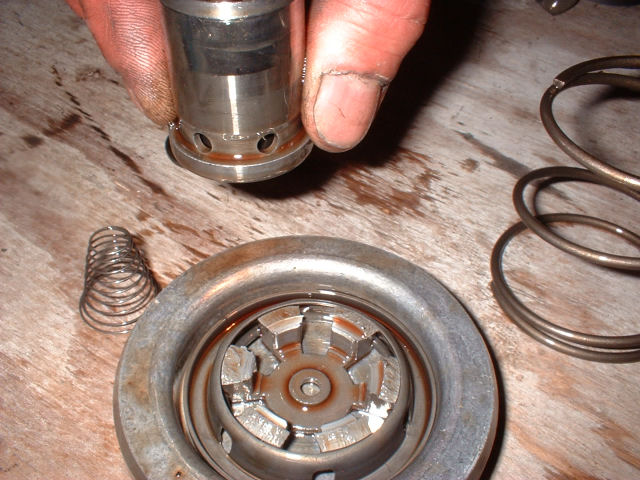 Broken B2 Piston |
|
About That Infamous B2 Piston
Why it breaks The broken B2 piston problem is a well understood and easy to fix transmission problem with certain Mercedes 722.xxx automatic transmissions found in 126, 123 and 107 body cars. Although the car is drivable with a busted B2, it's a bit tricky. There is a school of thought that says any pre 1994 MB with one of these should be replaced as preventative maintenance. |
 Broken B2 Piston |
|
In this picture you can see two parts to the B2 piston. The problem is it is supposed to be one piece, not two! There were a couple of design flaws with this part, common to most 80s and early 90's Mercedes cars. The piston actuates the B2 band, that is it helps shift gears. It's about 3" in diameter and this piston has about a 3" stroke. There is a deal around the outside of the piston, much like a piston ring. This piston rides in a metal sleeve. The seal was originally round, and the sleeve was metal. I saw was, because that design had problems that usually show up bewteen 100 and 200 thousand miles. What happens is the piston is activated and pushed inward in its bore. But, the round seal sometimes gets stuck (for whatever reason) and hydrauic pressure builds up to tremendous force so eventually it does move but by now there's so much pressre that when it does move it does so with increadable fource and eventually it snaps' the 3" collar and the flat disc separate by breaking at the base. That's what happeneed to that poor piston above. it happens to most of them eventually. Mercedes had several upgrades to these parts over the years and now we have new improves beefier B2 pistons that have a square seal instead of a round one, and a plastic sleve instead of a metal one. That seems to have fixed the problem. These new B2 pistons do not seem to fail. |
|
The symptoms of a B2 piston failure are unmistakable:
They fail anywhere between 100K and (in my case) 400K miles; chances are very high your first major problem with this transmission will be this one. But, things could be worse, the car is drivable when this failure occurs, although it takes some patience. It's worse when cold, and is made worse by how much load you put on it. The object of driving a car with a bad B2 piston is to never give it much load in 1st and 2nd gears. Think of parking on a hill facing down. You want to get the car into 3rd as soon as you can and 3rd and 4th are unaffected by even catastrophicB2 failure. You might even consider pulling the transmission vacuum line so it shifts way much too early into 3rd. I did. Seems to make driving in a car with this problem a little easier. On level ground what you'll find is it will go into gear once you put it in drive but will pop out almost immediately after you give it even the smallest amount of throttle. But, then it'll go back into great and now you might actually be able to get going withvery light throttle. Or it may pop out again and you're ok now till it shifts into second and you get to hear it pop out again, then it'll go back in and you'll be ok now. It'll probably shift into 3rd and 4th quite normally, so floor it and don't stop. If you stop you have to go through this ordeal of starting the car moving again. Starting the car going uphill is a near impossability, but it can be done. It's unlikely the car behind you will have the same kind of patience you have though. Wave and smile. Once the B2 piston has failed it's unknown how long you can actually drive it for before it pack in completely. I drove mine aroiund for 3 months till it warmed up enough outside to be able to fix it. It is not the end of the world. The good news is the repair can be made while the transmission is in the car in the case of a 126 it's pretty easy - in other chassis the trans needs to be dropped just a little although people have reported success, with some effort, of doing it to 123 and 107 chassis with the tranny in place. It's not a terribly expensive repair either, the part is about $100 and it'll take you a couple of hours. While there's a few steps to this it's really only a little worse than changing a spark plug and you don't need of be a master mechanic to do this. Here's how Richard Sexton |